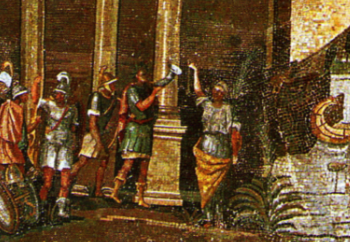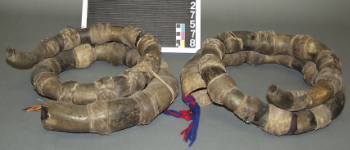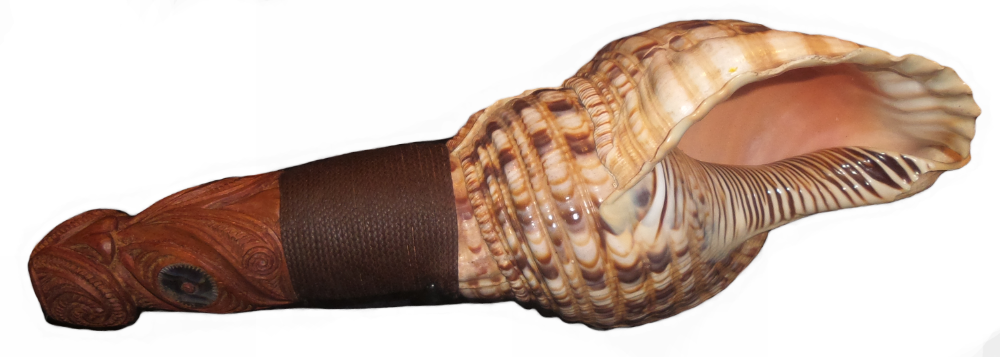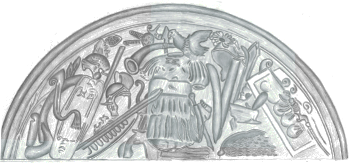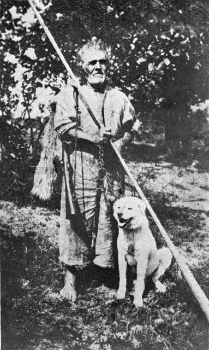Throughout the ancient world, there are many names given to brass instruments which incorporate the pu/bu sound. These are so numerous as to suggest that the confluence of names is more than a coincidence. It may well be that the sound of pu/bu is reminiscent of the blowing of a horn or trumpet or that the shape of the lips when making these sounds mimic the shape when blowing instruments.
What is probably the earliest possible written reference to brass instruments which utilises the pu/bu linkage is one which associates them with eternal life and comes in a document which tells the tale of the Sumerian hero Gilgamesh and dates from a period more than 1500 years before Tutankhamun, dating to between 4,000 and 3,000 BCE. While the gist of all the versions are the same is found in several tellings and these were replicated over several thousands of years, the earliest being written in Sumerian cuneiform and later ones in successor languages, Akkadian and Hittite.
The tale recounts how Gilgamesh sought to secure his immortality. It tells how he found a hollow tree in whose roots a serpent had made its nest and he chopped this down, then killing the serpent. Plucking up the tree by its roots, he offered the top of this to the Goddess Inanna. From the root of the tree, he makes a PUKKU and, from one of its branches, a MEKKU. Commanding all the assembled throng to remain silent, only the PUKKU and MEKKU are to make a sound. There is no way of knowing what was meant by the terms pukku and mekku but they could represent parts of a brass instrument such as the Korean folk instrument shown below.
I hear the Sumerian specialists saying whoah! at this stage and so they should because of the vast variations in interpretation of the cuneiform scripts with which these texts were created. Nevertheless, Canon Galpin said of this text: Now from this description we can certainly gather that the PUKKU and MEKKU were hollow pieces of wood and that, together, they formed a magical instrument which would make a sound: for the power of ‘calling’ is attributed to them, even to bringing back the faithful Enkidu from the realms of the departed. (Holmes 2022: p.55). Interestingly, Galpin picked up the theme of the calling of the instrument which is one echoed throughout the story of the brass.
In Peru and the Andes in general, one dual-gendered pair of instruments reported in the ethnographic literature has a name which contains the pu/bu root, the wakrapuku. In the Quechua language, it is known as the waqra phuku where waqra means horn and phuku to blow. While it is usually today made from cattle horn or metal, and are considered to be a post-Spanish conquest replacement for the earlier pututu, a shell horn, (Titanostrombus galeatus), which was used in pre-Columbian times. Today, it is created from interlocking sections of animal horns and is still in use as well as having been reported in ethnographic contexts. A pair of these instruments exhibit similar symmetry to the bronze lurs and the wakrapuku is found in use today in Peru and throughout the Andes generally. They exist as a pair of instruments in right and left-handed forms, a pair consisting of one each of a right and a left handed instrument. They are played in an annual fertility ritual and the actual instruments themselves are reported by the players as being male and female although in the reports I have seen, the players were unable to identify the individual genders of their instruments. (Holmes 2022: Figure 5.4) The image below shows a pair of wakrapuku.
This is one seen from a vastly-different place and time in the Maori instrument, the pututara. This composite, partly conch shell instrument is seen by the Maori as a gift of Tangaroa, the Maori sea God, and the wood of the mouthpiece as a similar gift from their forest God Tāne Mahuta. In joining these two elements together, the maker is seen in Maori culture to be joining the families of these Gods in peace. A somewhat different explanation from that given above in the case of the ancient instruments but, nevertheless, an explanation based upon the conjoining of two disparate elements in a desire to bring about harmony. (Holmes 2022: Figure 5.12, p.54). A pututara is shown in the image below and a Pututara sound can be heard here:
An instrument still in use and described over the years in ethnographic reports which incorporates the pu/bu root in its name is another Maori one, the putarino. This also incorporates the calling theme as it is shaped like the cocoon of the case moth and has a blowing device designed to allow it to be blown either as a brass instrument - when it is seen as being male - or as a flute - when it adopts a female persona. Thus, the instrument, being associated with both genders and, as with an overall shape of a cocoon, it forms a real-life Chamber of Creation, mimicking the chamber in which the case moth undergoes its metamorphism, before emerging as a newly-created moth. Whichever way it is played, the musician must ask permission of the spirit which resides within it before blowing. (Holmes 2022: Figure 5.7) A putorino is shown in the image below.
Another Pacific current and ethnographic instrument, the pu, is the Hawaiian Conch Shell instrument. It is linked to Hawaiian deities and its sound is seen as a call to the divine. As with the puterino, the blowing of this instrument should be accompanied by a ritual which recognises its relationship to the celestial sphere. When blown in some ceremonies, its call is said to symbolize both the journey of the Ancient Hawaiins as well as those of the player and hearers. Many Hawaiians it also see it as the personification the first four Hawaiian male Gods. The image below shows an Hawaiian pu instrument being blown
In Roman times, the Latin term bucina was used to describe an instrument but there is no definitive answer as to the form of that. One likely contender is that the bucina was a simple form of animal horn and some literary references suggest that it sometimes has silver fittings. I see the possibility of the term bucina having been derived from two roots, one Semitic viz. bu/pu and the other Proto-Indo-European via the term kern. Put together, these could form the composite term bu-kern. I have consulted Latin-language experts on this idea while pointing out that I have absolutely no evidence to substantiate this idea and their comment is that you have absolutely no evidence to substantiate this idea.
I have searched for other possible links to the pu/bu term in Latin and found only the term puteal in the Lewis and Short dictionary. Here they describe the puteal as the stone kerb round the mouth of a well, this sometimes lying nearly flush with the ground. This might seem to be an unlikely connection but one has to look at the meaning of sources of water in the ancient world. Here, they were seen as life-giving and were highly revered. The propensity of the abundance of nature to flow from them was mirrored in the Roman world by the cornucopia, the horn of plenty. Here the association of the horn with the power of nature is mirrored in the view of ancient brass instruments and may indicate some associations of the term between the brass and the puteal. Whatever their real meaning was, they were highly valued and Cicero is reported as wanting one. Their connection with nature and its impact on humans living under its influence is illustrated by the two sacred putealia which were erected over places struck by lightning, one in the Comitium and another in the Forum. The image below shows a Roman relief which contains a single horn-like instrument in the bottom left-hand corner which may have been one they described a bucina, IC615.
In modern-day Norway, the folk instrument, the bukkehorn is still played, this consisting of a ram’s horn with fingerholes. In Sweden, the same instrument is referred to as the bockhorn with some commentators suggesting that the name is derived from the name of the male sheep, ram or buck. That may be a modern adaptation of a more-ancient form. The image below is of a Swedish bockhorn: Swedish bockhorn by Musik – och teatermusik from Bockhorn in Wikipedia
The root of bu is found in the term bucium, this being a type of alphorn which is used in Romania and Moldova by mountain dwellers and by shepherds. The instrument is constructed from a variety of materials such as limetree bark, wood, or even sometimes from metal.The general view is that the name of the instrument is derived from the Latin term bucina. The image below is of a Romanian bucium. The image is of an old Romanian shepherd carrying what is described at the time as his trambita. It was taken at Giulesti.
Many historic and modern instruments such as the buisine and bugle appear to derive their form from the same root but these are derived from much-more recent cultures.
If you have succeeded in reading to here, you will no doubt be thinking how speculative some of this is. It is quite speculative but, in my opinion, it is quite valid to speculate as such a practice may trigger responses in readers who are more knowledgeable in the peripheral aspects of this subject and their ideas might move our thinking on.
